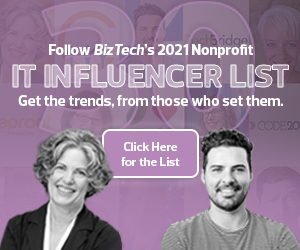A recent study by the financial technology news outlet PYMNTS.com finds that online giving grew by 12.1 percent in 2020. Most consumers expect to pay online with credit and debit cards (55 percent), but a sizable minority (15 percent) expect to use PayPal or another mobile wallet system. To not lose out, nonprofits need to accommodate each type of mobile payment.
That shift toward online payments will accelerate in the coming years. One trend in the fundraising space involves cryptocurrency, which can be used to make large payments. For example, the University of Pennsylvania recently accepted a $5 million donation in bitcoins from an anonymous donor.
Nonprofits may not get a big cryptocurrency infusion every day, but it would certainly be a good idea to have a plan for it, just in case.
Nonprofits Should Embrace No-Code Applications
As nonprofits look to build effective year-end campaigns that can work across a variety of settings, they may consider developing a splashy website or mobile app to lead a campaign or internal tools to track the campaign’s success. But development resources aren’t always readily available to organizations that operate with tight budgets and low overhead.
One solution to this dilemma might be found in low-code and no-code applications. No-code tools like Microsoft Power Apps, which can leverage different data inputs such as resources across cloud environments and donor databases, can be used internally for dashboards and externally for mobile apps or websites. And they often can be built by staff or volunteers who may not have access to (or a budget for) a technical team.
As mobile platforms remain an important way to grab attention, no-code applications can ensure that the development process ramps up as quickly as the rest of the annual campaign.
MORE FROM BIZTECH: Learn how nonprofits can be using automation to optimize donations.
And don’t gloss over the internal use cases — as the TechSoup study finds, more than two-thirds of organizations cite the cost of adoption as a limiting factor in the uptake of technology tools. But no-code’s ease of use could ensure less expensive application development over time. The productivity boost is a major factor as well: As Andy Bell of the U.K. nonprofit resource Catalyst noted in an article last year, nonprofits that were embracing no-code found that it helped expand their capabilities significantly.
“No-code was empowering them,” Bell wrote. “Technology had gone from being a deadweight to being a superpower.”
As amazing as it sounds, it’s still important to have a partner such as CDW ServiceNow Solutions to help keep your plan on the right track.
Double Down on Data Analytics
Nonprofits should be laser-focused on analytics, slicing and dicing their data to support effective targeting through email and social networks. But there’s room to take data analytics further by making changes in real time and responding proactively, which could maximize the results of a year-end campaign.
Real-time adjustments could provide growth for many organizations — the TechSoup study finds that while 78 percent gather data on beneficiaries, 71 percent gather data on financial issues and 70 percent build data around donors, just 29 percent collect other types of programmatic data, meaning they may be missing out on opportunities that don’t emerge from traditional data inputs.
With an effective data analytics strategy — perhaps using a tool such as Splunk or a dashboard built using a no-code app — nonprofits could look beyond the obvious points in their annual campaigns.
That’s where the true power lies when maximizing a year-end donor campaign: Looking beneath the surface, beyond the obvious. With a strong partner, you might be surprised what you can find.











